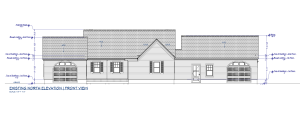If you’re a homeowner, you may be familiar with the permitting process. You may also know how confusing or time consuming this process can be. Clients should be prepared for potential delays in the permitting process for a home remodel or new construction build, as it can vary depending on the complexity of the project and the requirements of the permitting authorities.
Here are some things to be prepared for timeline wise:
- Civil Engineering: Civil engineering is being required by a lot of towns especially in higher density and money areas, as many towns want to watch their own liabilities. Many civil engineers are backlogged by 3-6 months, which could cause delays in your home project. Clients should be prepared for these potential delays as well as the need for plan revisions, additional information, or other unforeseen circumstances throughout the permitting process. Effective communication and collaboration with civil engineers are key to ensuring a smooth permitting process and successful completion of the project.
- FEMA: The Federal Emergency Management Agency, also known as FEMA, is the federal government’s lead agency in responding to disasters and crises. Clients should be prepared for a thorough and detailed permitting process when working with FEMA on a home remodel or new construction build. This process may involve various documentation requirements, inspections, and approvals from FEMA officials. FEMA may have specific requirements or regulations that must be met before a permit is issued. Depending on the scope of the project and the specific requirements of FEMA, there may also be fees or other expenses that need to be paid in order to obtain the necessary permits.
- Structural Engineering: Clients should be prepared for a detailed structural analysis of their project by structural engineers during the permitting process. Structural engineers will assess the structural integrity of the building plans to ensure they meet safety standards and building codes. Clients should also be prepared for potential revisions or modifications to the design plans to address any structural concerns identified during the review process. This could take a matter of weeks to months depending on the structural engineering firm you chose to work with as well as supply and demand.
- Architecture: Clients should be prepared for a thorough review of their architectural plans by architects during the permitting process. Architects will ensure that the design plans comply with local building codes, zoning regulations, and aesthetic guidelines. Potential revisions or modifications to the design plans may be needed to address any feedback or requirements from the permitting authorities. This process can take anywhere between 3-9 months.
Case Study
We have gone through our own permitting process difficulties. Here is a case study of a recent client design we’ve been trying to receive permits for:
Phase 1: This property is a single family home split into two sections, the main portion of the house and the garage on the left is the primary residence (Side B). The space and garage on the right hand side (Side A) is used for the homeowner’s parents to reside. The client had already made renovations to Side B and left Side A as is. The goal of this project is to add another garage and create additional square footage for a more comfortable living space.

Below is the floor plan which shows the space highlighted in blue as the existing footprint. The pink section is the proposed addition and the yellow shows the proposed deck in the front of the house.

Phase 2: The next phase of this project is to add a garage bay with an Accessory Dwelling Unit (ADU) above the garage on Side B. The ADU space will consist of a primary suite with two closets, a primary bathroom, and an office space. The previous smaller primary suite will be converted into a hallway that will lead to the additional second floor space seen in the middle section of the home.

While this plan makes sense from an architectural perspective and follows all the codes, we have been back and forth for nearly a year trying to receive permits from the building inspector.
The Setback:
The town building inspector who reviews and approves plans didn’t quite understand the existing and proposed home plan layout. Because of this, the building inspector wouldn’t give the homeowner the Certificate of Occupancy (CO) after Phase 1 was completed.
A certificate of occupancy is typically issued by the local building department after a property is built, renovated, or changes ownership or use. This is a legal document that verifies a property meets all local codes and usage requirements and that it is safe to live in.
In our case, the homeowner had already passed all of the inspections for Phase 1 but couldn’t apply for a permit for Phase 2 of the project until Phase 1 was closed. Phase 1 couldn’t be closed until she got her CO from the building inspector, so this resulted in major setbacks and delays.
Current Stage:
After several months of setbacks, the builder sat down with the building inspector to discuss the plans in depth so he could better understand and receive approval for a permit to start construction. A permit has yet to be approved but we are hopeful to receive a permit for Phase 2 soon.
If you would like to learn more about the permitting process and are you wondering what you are up against when it comes to getting final approval on a project, read our blog Permitting Process 101. If you are completely confused on where to begin, consider booking a free consultation with Amy here to help you through the permitting process!
